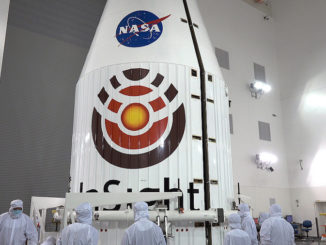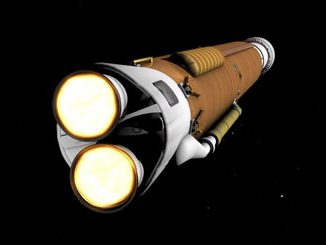Payload: TRACKING AND DATA RELAY SATELLITE-M
NASA geosynchronous communications satellite
Relays data from ISS, Hubble and LEO customers
Cost: $408 million satellite + $132m launch service
Launch Date: Friday, Aug. 18, 2017
Launch Window: 40 minutes
8:03-8:43 a.m. EDT
1203-1243 GMT
Launch Site: Cape Canaveral Air Force Station, Florida
Space Launch Complex 41
Customer: NASA
Launch Services Program, Kennedy Space Center
TDRSS Project, Goddard Space Flight Center
Launch Services
Provider: United Launch Alliance, Centennial, Colorado
Launch Vehicle: Atlas 5 designated AV-074
401 configuration
Weight at liftoff: 745,000 pounds
Height: 191 feet (58 m)
Common Core Booster with RD-180 engine
73,800 gallons RP-1 kerosene and liquid oxygen
Thrust: 860,300 pounds
Centaur upper stage with RL10C-1 engine
16,450 gallons liquid hydrogen and oxygen
Thrust: 23,300 pounds
Extended Payload Fairing
14-foot-dia., 42-foot-tall aluminum shroud
Construction: Atlas stage and Centaur upper stage built by
United Launch Alliance in Decatur, Alabama
Fairing manufactured by ULA in Harlingen, Texas
RD-180 from NPO Energomash, Khimki, Russia
RL10C-1 from Aerojet Rocketdyne, West Palm
Beach, Florida
Satellite Builder: Boeing Space and Missile Systems unit within
Defense, Space & Security (BDS) division
Manufactured at Boeing's Satellite Development
Center, El Segundo, California
Satellite Use: The TDRS-M satellite provides follow-on and
replacement capacity to maintain and
expand NASA's Space Network that supplies
near-continuous high bandwidth (S-, Ku-
and Ka-band) telecommunications services
for data-relay and tracking low-Earth
orbiting user spacecraft and launch
vehicles, including the Hubble Space
Telescope, the International Space Station
and NASA's science observatories.
Satellite Statistics: Model: Boeing 601HP
Tri-frequency communications: S-, Ku-, Ka-band
Launch mass: approx. 7,610 pounds (3,452 kg)
Height: 27 feet in launch configuration
Wingspan: Solar arrays 69 feet tip-to-tip
Antennas: Two 15-foot-diameter steerable, flexible
graphite composite mesh Single Access
reflectors and one 7-foot-diameter
Space-to-Ground Link
Propulsion: R-4D 100-pound-thrust main engine
Mission life: 15 years
Orbital test slot: 150 degrees West
Operational orbital slot: likely above Atlantic
History: The TDRS Project was established in 1973 and is
responsible for the development, launch
and on-orbit test and calibration of TDRS
spacecraft.
There have been four procurements of TDRS
spacecraft, which include the Basic
Program (TDRS-F1-F6), the Replacement
Program (TDRS-F7), the TDRS-H, I, J
Program, and the TDRS-K, L, M Program.
The first seven spacecraft (TDRS-F1-F7) are
referred to as the First Generation, the
H, I, J series as the Second Generation,
and the K, L, M series the Third
Generation.
TDRS-F1-F7 spacecraft were built by TRW (now
Northrop Grumman) in Redondo Beach,
California. Hughes (now Boeing) in El
Segundo, California built all of the
subsequent spacecraft.
The contract to build the next generation of
TDRS spacecraft, known as TDRS-K and L,
was awarded to Boeing Space Systems in
December 2007. An option to the contract
was exercised in November 2011, adding the
development of TDRS-M.
TDRS-A Challenger • STS-6
Launch date: April 4, 1983
Retired in 2010, boosted to super-synchronous orbit.
TDRS-B Challenger • STS-51L
Launch date: January 28, 1986
Destroyed in launch failure.
TDRS-C Discovery • STS-26
Launch date: September 29, 1988
Located at 64 degrees West longitude over the Atlantic Ocean region.
TDRS-D Discovery • STS-29
Launch date: March 13, 1989
Retired in 2011, boosted to super-synchronous orbit.
TDRS-E Atlantis • STS-43
Launch date: August 2, 1991
Located at 167 degrees West longitude over the Pacific Ocean region.
TDRS-F Endeavour • STS-54
Launch date: January 13, 1993
Located at 47 degrees West longitude over the Atlantic Ocean region.
TDRS-G Discovery • STS-70
Launch date: July 13, 1995
Located at 84 degrees East longitude over the Indian Ocean region.
TDRS-H Atlas 2A • AC-139
Launch date: June 30, 2000
Located at 90 degrees East longitude over the Indian Ocean region.
TDRS-I Atlas 2A • AC-143
Launch date: March 8, 2002
Located at 12 degrees West longitude over the Atlantic Ocean region.
TDRS-J Atlas 2A • AC-144
Launch date: Dec. 4, 2002
Located at 174 degrees West longitude over the Pacific Ocean region.
TDRS-K Atlas 5 • AV-036
Launch date: Jan. 30, 2013
Located at 171 degrees West longitude over the Pacific Ocean region.
TDRS-L Atlas 5 • AV-043
Launch date: Jan. 23, 2014
Located at 41 degrees West longitude over the Atlantic Ocean region.
Mission Profile: The Atlas 5 will place TDRS-M into space using
a high-perigee geosynchronous transfer
orbit mission design. This launch will use
a parking orbit ascent trajectory with two
Centaur burn phases. The satellite's own
attitude and orbital control system will
perform a series of burns to raise perigee
to geosynchronous altitude for orbit
circularization and reduce inclination.
* Sequence of events *
T-0:00:02.7...RD-180 engine ignition
T+0:00:01.1...Liftoff
T+0:00:17.7...Begin pitch/yaw maneuver
T+0:01:20.0...Mach 1
T+0:01:31.8...Maximum dynamic pressure
T+0:04:02.2...Atlas booster engine cutoff (BECO)
T+0:04:08.2...Atlas/Centaur separation
T+0:04:18.2...Centaur first main engine start (MES 1)
T+0:04:26.2...Payload fairing jettison
T+0:17:57.7...Centaur first main engine cutoff (MECO 1)
T+1:48:03.7...Centaur second main engine start (MES 2)
T+1:49:00.1...Centaur second main engine cutoff (MECO 2)
T+1:53:46.1...TDRS-M separation
Separation parameters: Apogee altitude: 22,237 statute miles
Perigee altitude: 2,883 statute miles
Inclination: 26.2 degrees
* Launch statistics *
- The 654th launch for Atlas program since 1957
- The 358th Atlas launch from Cape Canaveral
- The 243rd mission of a Centaur upper stage
- The 220th use of Centaur by an Atlas rocket
- The 481st production RL10 engine to be launched
- The 20th RL10C-1 engine launched
- The 78th flight of an RD-180 main engine
- The 72nd launch of an Atlas 5 since 2002
- The 15th NASA use of Atlas 5
- The 59th launch of an Atlas 5 from Cape Canaveral
- The 4th Atlas 5 launch of 2017
- The 107th Evolved Expendable Launch Vehicle flight
- The 120th United Launch Alliance flight overall
- The 64th Atlas 5 under United Launch Alliance
- The 87th United Launch Alliance flight from Cape Canaveral
- The 28th NASA launch by United Launch Alliance
- The 50th 400-series flight of the Atlas 5
- The 37th Atlas 5 to fly in the 401 configuration
- The 86th launch from Complex 41
- The 59th Atlas 5 to use Complex 41
- The 13th TDRS spacecraft to launch
- The 6th TDRS to launch on Atlas
- The 6th Boeing-built TDRS
* GENERAL PUBLIC VIEWING *
An optimal spot for the general public to view the morning launch will be Playalinda Beach, located just north of Complex 41 along the Canaveral National Seashore and accessed from Titusville via State Highway 402.
Walking down the beach to the barrier fence line will put you just 4.8 miles away from the rocket at takeoff.
The park charges a small fee per car to enter.
The Kennedy Space Center Visitor Complex also offers viewing options, but those require the standard admission fee plus a launch access pass, per person.
More Information: Spaceflight Now's live countdown journal and
launch webcast will be available on
spaceflightnow.com
Twitter Feeds:
twitter.com/SpaceflightNow
twitter.com/NASA
twitter.com/NASA_TDRS
twitter.com/NASA_LSP
twitter.com/torybruno
twitter.com/ULAlaunch
twitter.com/BoeingDefense
twitter.com/AerojetRdyne
© 1999-2024 Spaceflight Now Inc



